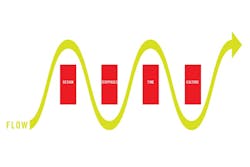This column follows last month’s discussion about trying to do the “wrong things righter.” I based my points around a profound statement by the esteemed organizational theorist Russell L. Ackoff. In simple terms, Ackoff states that trying to continually repair a system that doesn’t work in the first place will not deliver anywhere near the results that a slightly broken “right” system will.
This applies to the current collision repair process or system; it’s broken, and analyzing departmental inefficiencies will not make the broken system perform well. You’re simply putting a Band-Aid on the symptoms, not curing the underlying issue.
This is where the study of systems thinking allows you to look at process models holistically and start to remove the conflicts in the system, as well as review things from a bottom-up point of view. As businesses grow, processes and procedures inevitably become more robust and onerous, imposing a top-down culture within the business. It often creates a downward spiral in output and a disconnect between management and workforce.
When we grow our organizations larger, things become more departmentalized in the pursuit of efficiency gains and localized management ease. At that point, decisions are made at a local level and often without the correct management information to enable the department to add value to the business as a whole.
The specific department in these cases may well see a gain. However, as a whole, the business output may significantly suffer because of moved bottlenecks, isolated thinking and more difficult management requirements. For example, an insurance carrier may write a service level agreement with you to repair all the vehicles they can throw at you from a specific ZIP code; but in fact, it just bogs you down. It means you operate less efficiently than normal and it extends the cycle. It would have been much cheaper and better for the customer if you had a more flexible “pull” system based upon capacity and sent the driver to a shop around the corner who could have repaired it much quicker—and by definition, probably cheaper, overall.
When considering whether the collision industry does things either the wrong or the right way, you have to look at the whole model holistically, ignore the departmental silos and study overall flow. Flow in any system is what means faster, cheaper and better vehicle repair (and by definition, more profitable). It’s flow we should all be striving for.
So the key two questions we have to ask ourselves are: What is it that determines flow in our business? And, what is it that stops flow in our business? These appear to be two very similar questions, but once you get to the root cause of them, you will derive two very different answers.
If we look at the first question, we are trying to find out how to optimize flow and, therefore, throughput. Remember that a repair order just costs you money until the moment it is invoiced and out of the door, and more work-in-progress hemorrhages your business. For example, when we look at a coned-off freeway, you notice that the bottleneck that is created causes a slowing of output (cars passing the roadwork), and chaos upstream as everyone jostles to get in the correct lane. Transpose that simple thought back to your shop, and you’ll see that it’s the bottlenecks that control overall throughput.
When it comes to the second question, research shows there are actually just four key things that stop flow in our business, extending cycle and increasing the cost and chaos. If you were wondering, these are: departmental design, unexpected stoppages in production (we call these Murphys), drying time, and culture. Our own thinking and beliefs in what is right or wrong can stop us from doing the right thing.
As you are probably beginning to see, this leads into a very big subject, one that touches every single part of the collision repair process, culture, technology and environment. There are companies trying to help shops fight this, including mine, Bodyshop Revolution North America Inc. The overall goal for our industry needs to be focused on helping shops understand the theories and methodology to do the “right things righter.” That’s the only way to solve current issues.
Jon Parker is managing director of the Byteback Group, a U.K.-based information technology and services company aimed at advancing the collision repair industry. Parker can be reached at [email protected].
